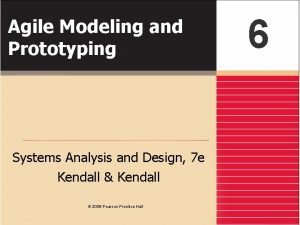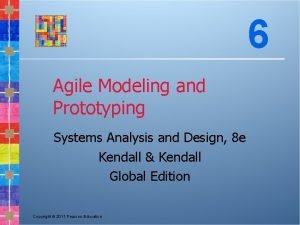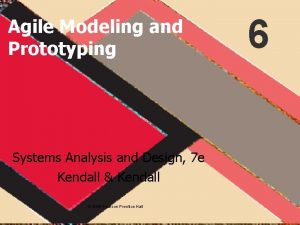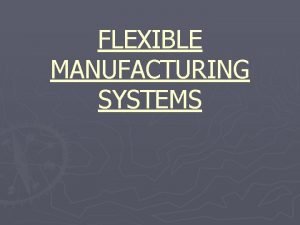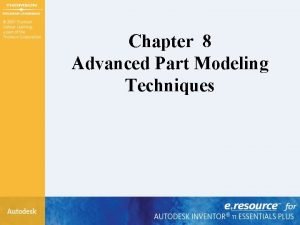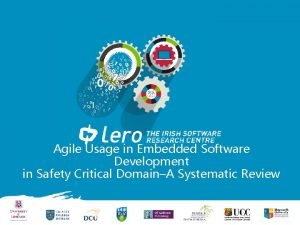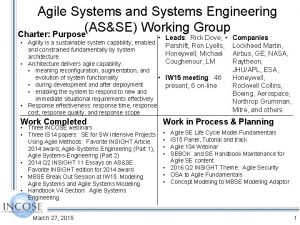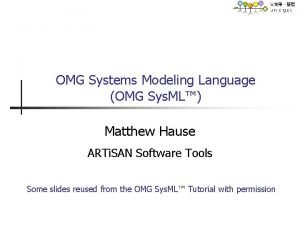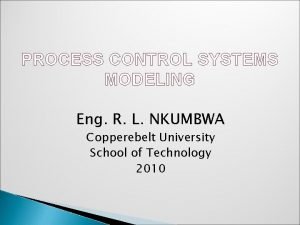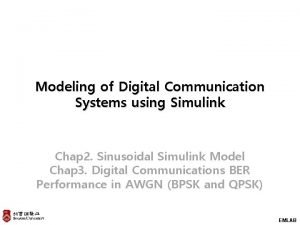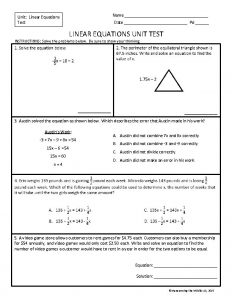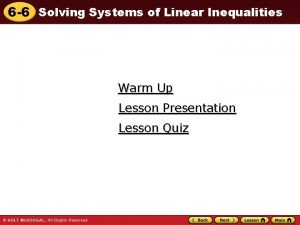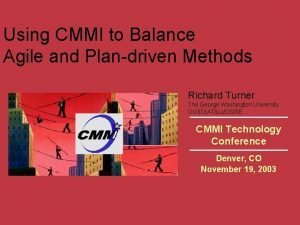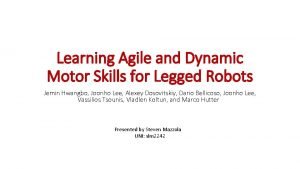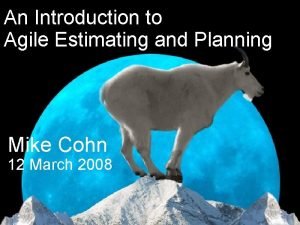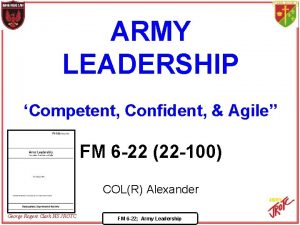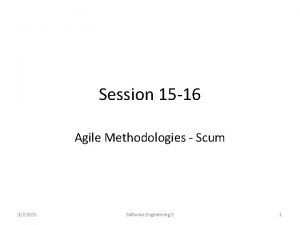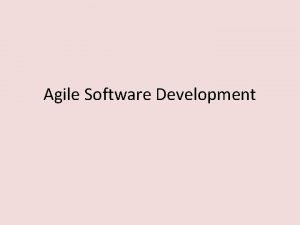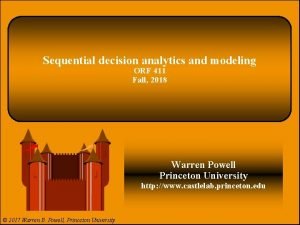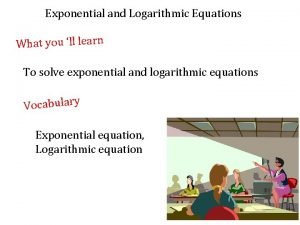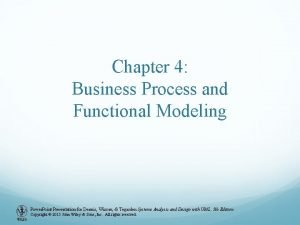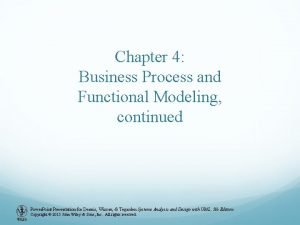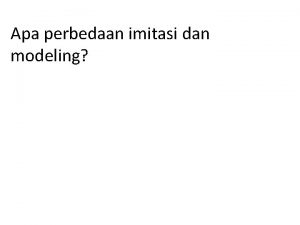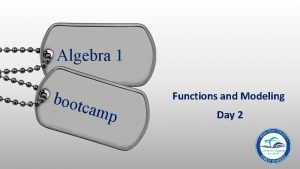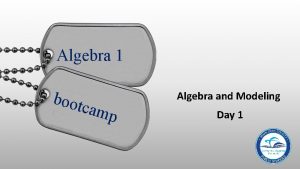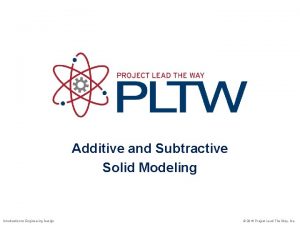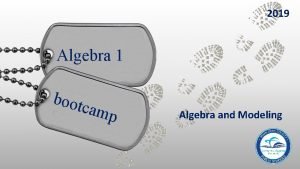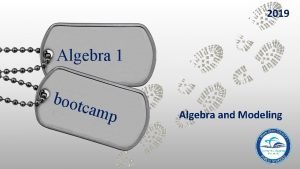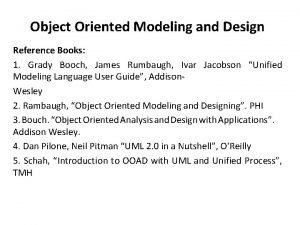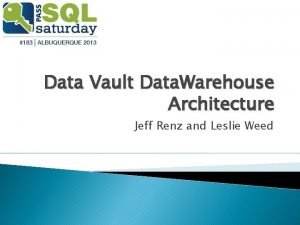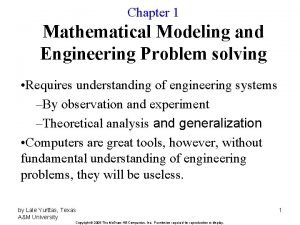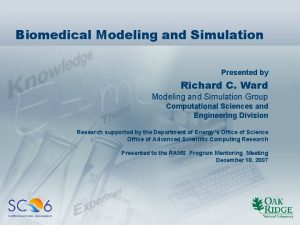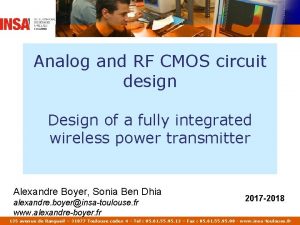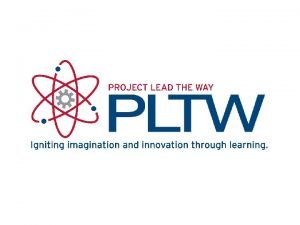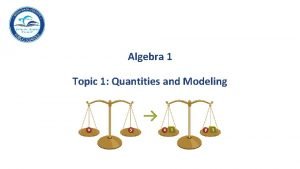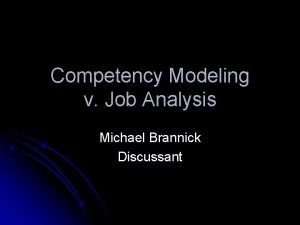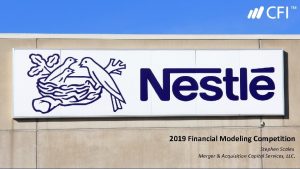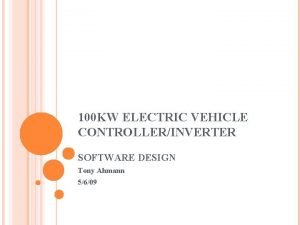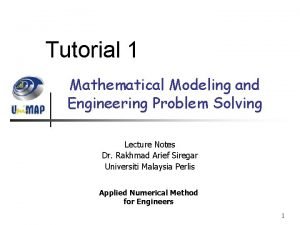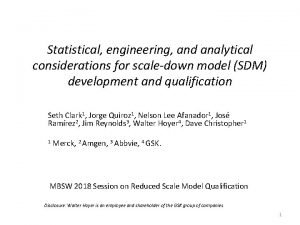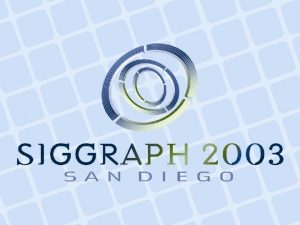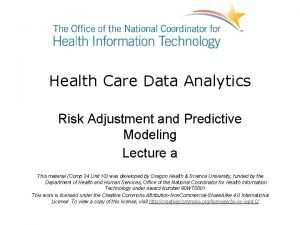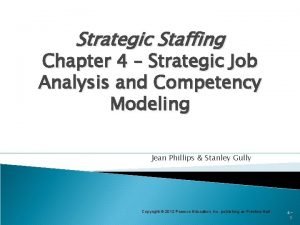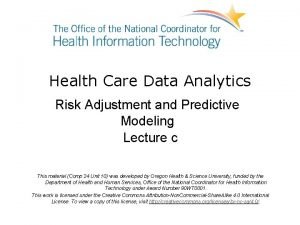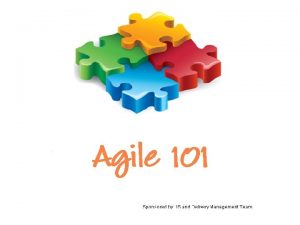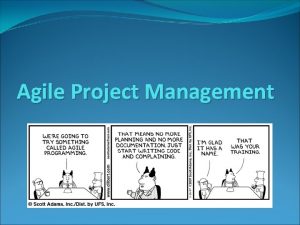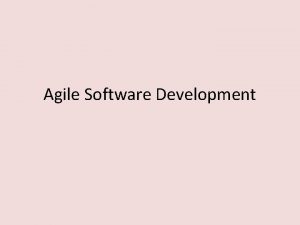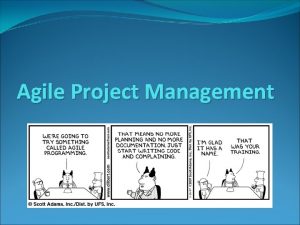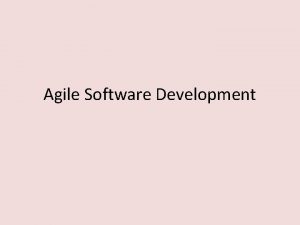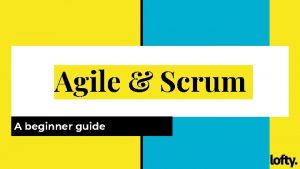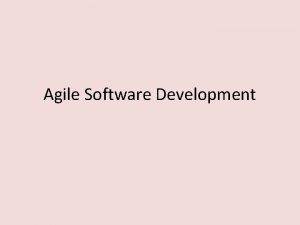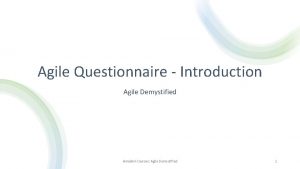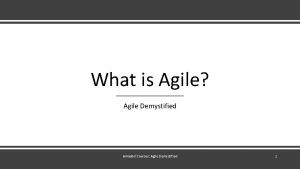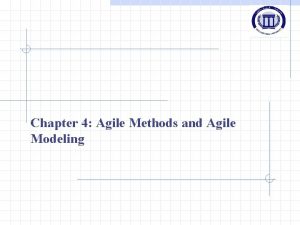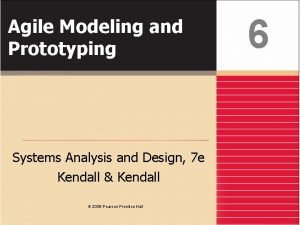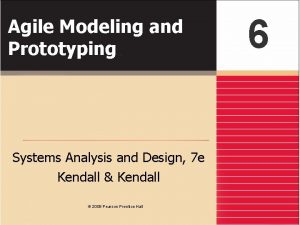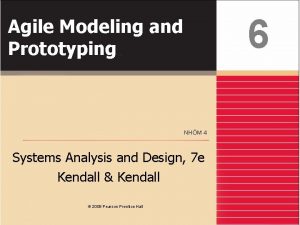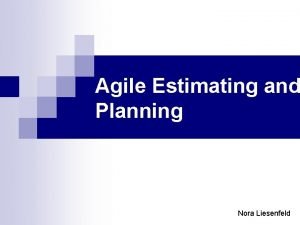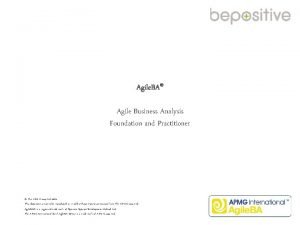Agile Modeling and Modeling Agile Systems 3 Part
















































































- Slides: 80

Agile Modeling and Modeling Agile Systems 3 Part Workshop IW 15 – Saturday 24 Jan 2015 Part 1 – The Agile Architecture Pattern as a model-based system pattern, with implications for agile modeling Rick Dove rick. dove@parshift. com, attributed copies permitted 1

American Football http: //football. about. com/od/footballpositions/Football_Positions. htm 11 players on field per side Offensive positions: 8 with some pairs Defensive positions: 6 with many pairs Special teams positions: 7 with some multiples Adaptation is an immediate, appropriate, different response in functionality. This can only occur if functional resources can be added, modified, or reconfigured quickly. A good sports team has more players than it fields at any one time, so that the coach can mix and match the players’ skill-sets according to the opposition, the situation, and real-time developments. Reconfiguring a sports team with different players during game time doesn’t work, though, if players bring their own rules with them. The players all know the rules of the game and they all know their team’s playbook. The coach exercises a dragand-drop, plug-and-play operational strategy enabled by an actively managed team-system structure. Complex system behaviors arise from the interactions of simple rules. Were this not the case, it would be impossible to sustain complex behavior in the face of increased opportunities for failure. rick. dove@parshift. com, attributed copies permitted 2

Today's Agility Interest – Origin & Continuation 1991 – Sec. Def funded project at Lehigh University to identify next manufacturing competitive focus beyond Lean – 13 companies participated full-time in 3 -month workshop – 2 vol report: 21 st Century Manufacturing Enterprise Strategy – Problem/opportunity defined (for manufacturing enterprises) 1992 – Agile Manufacturing Enterprise Forum founded at Lehigh, funded by Texas Instruments and General Motors – Purpose: Identify nature of Agile solution – Method: Industry collaborative workshop groups 1994 – DARPA/NSF establish $5 Million x 5 year funding – Name changed to Agility Forum (any kind of enterprise) – Research steering group and agenda established – 250+ orgs, 1000+ participants in focused workshop groups – Conferences, papers, reference base, tools, reference model 1998 – Mission accomplished, Agility Forum dissolved – Agility pursuit by industry and IT vendors entrenched Since then – Confirmation & employment in various projects – Many graduate SE student term and masters projects – Refinement of architectural concepts, no basic changes rick. dove@parshift. com, attributed copies permitted 3

Agile-Systems Research Focus – 1991+ Problem: - Technology and markets are changing faster than the ability to employ/accommodate - Life cycle requirements are uncertain and unpredictable - Flexible system approaches inadequate when requirements change - New approach needed that could extend usefulness/life of systems Solution Search: - Examined 100 s of systems of various types - Looked for systems that responded effectively - Looked for metrics that defined effectively - Looked for categories of response types - Looked for principles that enabled response Note: This research took place at the Agility Forum 1992 -1996, and in subsequent independent research 1997 -1999 Essays chronicle knowledge development at www. parshift. com/library. htm rick. dove@parshift. com, attributed copies permitted 4

Agility - Fundamentally The Ability to Thrive in a Continuously Changing, Unpredictable Environment. Agility is effective response to opportunity and problem, within mission. . . always … no matter what. An effective response is one that is: Metric n timely (fast enough to deliver value), time n affordable (at a cost that leaves room for an ROI), cost n predictable (can be counted on to meet expectations), predictability n comprehensive (anything/everything within mission boundary). scope You can think of Agility as Requisite Variety. You can think of Agility as proactive Risk Management. You can think of Agility as Innovative Response in unpredictable situations. You can think of Agility as Life Cycle Extension. The trick is understanding the nature of agile-enabling fundamentals, and how they can be applied to any type of system/process. Domain Independent rick. dove@parshift. com, attributed copies permitted 5

Agility deals with “design-for-transformation”. In a very general interpretation, Lean values efficiency of operation and achieves this mainly through operational principles; Agile values effective response ability and achieves this mainly through architectural principles. Lean: Process/System Operation Lean & Agile: Orthogonal Focus Agile: Process/System Transformation Both are concerned with operational effectiveness. Since the two have a different means for achieving different ends they are not necessarily in one-or -the-other conflict – but can be. rick. dove@parshift. com, attributed copies permitted 6

The UURVE Environment Drives the Response Need Agile systems are defined in counterpoint to their operating environments. Words used to describe the general nature of the target environment often include and combine dynamic, unpredictable, uncertain, risky, variable, and changing, with little attention to clear distinction among them. To design and develop a system that can deal effectively with changing environments it is useful to articulate the nature of changes that should be considered. Agile systems have effective situational response options, within mission, under: • Unpredictability: randomness among unknowable possibilities. • Uncertainty: randomness among known possibilities with unknowable probabilities. • Risk: randomness among known possibilities with knowable probabilities. • Variation: randomness among knowable variables and knowable variance ranges. • Evolution: gradual (relatively) successive developments. The difference between risk and variation in this framework is that risk is viewed as the possible occurrence of a discrete event (a strike keeps all employees away), while variation is viewed as the intensity of a possible event (absenteeism varies with the season). rick. dove@parshift. com, attributed copies permitted 7

7 Thought-Guiding Frameworks (this discussion’s focus in yellow) Response requirements categories (4 reactive and 4 proactive elements): Reactive: correction, variation, expansion, reconfiguration Proactive: creation, improvement, migration, modification Response performance metrics (4 elements): Response: cost, time, quality, scope Response-enabling design principles (10 elements): Encapsulation, Compatibility, Reusability, Redundancy/Diversity, Scalability, Distributed, Loose, Deferred Commitment, Self-Organizing, Evolving Standards Design quality principles (3 elements): Requisite Variety, Parsimony, Harmony An overarching architectural philosophy (3 elements): Reusable modules Reconfigurable in a Scalable architecture (RRS) Agility-sustaining responsibilities (4 elements): Module Mix Evolution, System Assembly/Reconfiguration Module Readiness, Infrastructure Evolution An agile architecture pattern: Drag-and drop modules in a plug-and-play infrastructure rick. dove@parshift. com, attributed copies permitted 8

Objective: System X-Ray Vision http: //awespendo. us/animemangacomics/kermit-at-the-doctor/ rick. dove@parshift. com, attributed copies permitted 9

“On How Agile Systems Gracefully Migrate Across Next-Generation Life Cycle Boundaries” www. parshift. com/Files/Psi. Docs/Pap 080614 Glo. Gift 08 -Life. Cycle. Migration. pdf Case: Home Entertainment Technology Migration agile architecture pattern: drag-and-drop, plug-and-play Encapsulated Modules amplifiers speakers signal tuners playback units video displays content sources (tape, CD, DVD) ) (TV, computer) (TIVO, P 2 P) rick. dove@parshift. com, attributed copies permitted Drag-and-Drop Reusable Components 10

“On How Agile Systems Gracefully Migrate Across Next-Generation Life Cycle Boundaries” www. parshift. com/Files/Psi. Docs/Pap 080614 Glo. Gift 08 -Life. Cycle. Migration. pdf Case: Home Entertainment Technology Migration agile architecture pattern: drag-and-drop, plug-and-play Encapsulated Modules amplifiers speakers signal tuners playback units video displays content sources (tape, CD, DVD) ) (TV, computer) (TIVO, P 2 P) Drag-and-Drop Reusable Components Examples of Typical Reconfigurable/Scalable System Configurations Audio tape Video media rick. dove@parshift. com, attributed copies permitted Net in/out 11

“On How Agile Systems Gracefully Migrate Across Next-Generation Life Cycle Boundaries” www. parshift. com/Files/Psi. Docs/Pap 080614 Glo. Gift 08 -Life. Cycle. Migration. pdf Case: Home Entertainment Technology Migration agile architecture pattern: drag-and-drop, plug-and-play Encapsulated Modules amplifiers speakers signal tuners playback units video displays content sources (tape, CD, DVD) ) (TV, computer) (TIVO, P 2 P) Drag-and-Drop Reusable Components Examples of Typical Reconfigurable/Scalable System Configurations Audio tape Video media Video/Surround ‘ 40 s/’ 50 s Net in/out Digital/Internet ‘ 90 s rick. dove@parshift. com, attributed copies permitted Plug-and-Play Evolving Passive Infrastructure Rules/Standards/Principles ‘ 00 s 12

“On How Agile Systems Gracefully Migrate Across Next-Generation Life Cycle Boundaries” www. parshift. com/Files/Psi. Docs/Pap 080614 Glo. Gift 08 -Life. Cycle. Migration. pdf Case: Home Entertainment Technology Migration agile architecture pattern: drag-and-drop, plug-and-play Encapsulated Modules amplifiers speakers signal tuners playback units video displays content sources (tape, CD, DVD) ) Assembly (TV, computer) (TIVO, P 2 P) Drag-and-Drop Reusable Components Plug-and-Play Evolving Active Infrastructure Responsible-Parties User/Owner Examples of Typical Reconfigurable/Scalable System Configurations Audio tape Video media Video/Surround ‘ 40 s/’ 50 s Net in/out Digital/Internet ‘ 90 s rick. dove@parshift. com, attributed copies permitted Plug-and-Play Evolving Passive Infrastructure Rules/Standards/Principles ‘ 00 s 13

“On How Agile Systems Gracefully Migrate Across Next-Generation Life Cycle Boundaries” www. parshift. com/Files/Psi. Docs/Pap 080614 Glo. Gift 08 -Life. Cycle. Migration. pdf Case: Home Entertainment Technology Migration agile architecture pattern: drag-and-drop, plug-and-play Encapsulated Modules amplifiers speakers signal tuners playback units video displays content sources (tape, CD, DVD) ) Readiness Stores Assembly User/Owner (TV, computer) (TIVO, P 2 P) Drag-and-Drop Reusable Components Plug-and-Play Evolving Active Infrastructure Responsible-Parties Examples of Typical Reconfigurable/Scalable System Configurations Audio tape Video media Video/Surround ‘ 40 s/’ 50 s Net in/out Digital/Internet ‘ 90 s rick. dove@parshift. com, attributed copies permitted Plug-and-Play Evolving Passive Infrastructure Rules/Standards/Principles ‘ 00 s 14

“On How Agile Systems Gracefully Migrate Across Next-Generation Life Cycle Boundaries” www. parshift. com/Files/Psi. Docs/Pap 080614 Glo. Gift 08 -Life. Cycle. Migration. pdf Case: Home Entertainment Technology Migration agile architecture pattern: drag-and-drop, plug-and-play Encapsulated Modules amplifiers speakers signal tuners playback units video displays content sources (tape, CD, DVD) ) Mix Mfgrs Readiness Stores Assembly User/Owner (TV, computer) (TIVO, P 2 P) Drag-and-Drop Reusable Components Plug-and-Play Evolving Active Infrastructure Responsible-Parties Examples of Typical Reconfigurable/Scalable System Configurations Audio tape Video media Video/Surround ‘ 40 s/’ 50 s Net in/out Digital/Internet ‘ 90 s rick. dove@parshift. com, attributed copies permitted Plug-and-Play Evolving Passive Infrastructure Rules/Standards/Principles ‘ 00 s 15

“On How Agile Systems Gracefully Migrate Across Next-Generation Life Cycle Boundaries” www. parshift. com/Files/Psi. Docs/Pap 080614 Glo. Gift 08 -Life. Cycle. Migration. pdf Case: Home Entertainment Technology Migration agile architecture pattern: drag-and-drop, plug-and-play Encapsulated Modules amplifiers speakers signal tuners playback units video displays content sources (tape, CD, DVD) ) Mix Mfgrs Readiness Stores Assembly Infrastructure Evolution User/Owner (TV, computer) (TIVO, P 2 P) Drag-and-Drop Reusable Components Plug-and-Play Evolving Active Infrastructure Responsible-Parties Industry Assocs Examples of Typical Reconfigurable/Scalable System Configurations Audio tape Video media Video/Surround ‘ 40 s/’ 50 s Net in/out Digital/Internet ‘ 90 s rick. dove@parshift. com, attributed copies permitted Plug-and-Play Evolving Passive Infrastructure Rules/Standards/Principles ‘ 00 s 16

Fundamental Concept Reusable modules Reconfigurable in a Scalable architecture (RRS) agile architecture pattern: drag-and-drop, plug-and-play Encapsulated Modules type C type B type A Mix Who? Readiness Who? Assembly Infrastructure Evolution Who? type D . . . . type n Drag-and-Drop Reusable Components Plug-and-Play Evolving Active Infrastructure Responsible-Parties Who? Examples of Typical Reconfigurable/Scalable System Configurations Type 1 Type 2 Generation 2 Type 3 Generation 3 Plug-and-Play Evolving Passive Infrastructure Rules/Standards/Principles Variety/Time/Maturity/Range/Increments/Migrations/Evolutions/etc rick. dove@parshift. com, attributed copies permitted 17

Who/What is Accountable Sustainability & Effectiveness The “active” parts of the infrastructure Module Mix Evolution: • Who (or what process) is responsible for ensuring that existing modules are upgraded, new modules are added, and inadequate modules are removed, in time to satisfy response needs? Module Readiness : • Who (or what process) is responsible for ensuring that sufficient modules are ready for deployment at unpredictable times? System Assembly/Reconfiguration: • Who (or what process) assembles new system configurations when new situations require something different in capability? Infrastructure Evolution: • Who (or what process) is responsible for evolving the passive and active infrastructures as new rules and standards become appropriate to enable next generation capability. The “passive” parts of the infrastructure are the interoperability standards rick. dove@parshift. com, attributed copies permitted 18

Agile Architecture Pattern (AAP) Notional Concept: System Response-Construction Kit Details in www. parshift. com/s/140630 IS 14 -Agile. Systems. Engineering-Part 1&2. pdf Modules/Components Integrity Management Module mix evolution Gears/Pulleys Motors Wheels Joiners, Axles, Small Parts Structural Material Product System Eng. Module readiness Retail Distribution Process System assembly Owner/Builder Infrastructure evolution Tools Product Manager Active Infrastructure Passive Helicopter Plane Sockets Signals Security Safety Service Rules/Standards Parts Interconnect Standards (None) Harm-Proofing Standards Process Rules & Con. Ops Mobile Radar Control Protocol Radio Control Standards rick. dove@parshift. com, attributed copies permitted 19

Case: Aircraft Refurb QRC Jason Boss masters project, Agile Aircraft Installation Architecture In a Quick Reaction Capability Environment, INCOSE IS 10, Chicago, July 12 -15. www. parshift. com/Files/Psi. Docs/Pap 100712 IS 10 -Agile. Aircraft. Installation. Architecture. pdf q q q q Mission system installation in military acquisition context. Customer’s need for the latest technology. Technology advances are creating new mission systems at an increasing rate, driving the demand for QRC. Goal is to shorten the completion time without compromising quality. Mission requirements and “boxes” often change late. Army wants QRC for intelligence surveillance reconnaissance (ISR) to be robust, scalable, tailorable. Air Force wants QRC challenges continually met, success is measured in rapidly adapted Electronic Warfare. rick. dove@parshift. com, attributed copies permitted 20

Example: Agile vs. Traditional Power Distribution Traditionally a breaker centralized panel distributes power to each box, creating an interface for every box and many wire routing paths. Some aircraft contain over 1000 boxes, and wire routing becomes a large modification effort. To reduce the number of interfaces, decrease wire routing effort, and allow rack modularity, the power distribution can be moved from the aircraft to within the rack itself. A single breaker then provides power to the rack, and a secondary breaker panel within the rack would distribute power to each box. Remote controlled solid state power controllers (SSPCs) allows re-programming an SSPC instead of changing a breaker out and routing a new wire between the breaker box and the rack. Rack becomes an encapsulated module. Power infrastructure is minimal. rick. dove@parshift. com, attributed copies permitted 21

Example: Modular Rack Cooling Solution mitigates the rerouting effort of existing aircraft ductwork. The proposed cooling architecture is really a combination of a cold air distribution subsystem that gets cold air from the aircraft source to the boxes, and a hot air exhaust subsystem that must dispose of the waste air. Rack becomes an encapsulated module. Cooling infrastructure is minimal. rick. dove@parshift. com, attributed copies permitted 22

Encapsulated Modules, Minimal Infrastructure Aircraft installation infrastructure is modified… once. The SIL* has a duplicate infrastructure. “Everything” is fully integrated and tested in the SIL … before the aircraft arrives. Aircraft installation is a simple relocation of pluggable modules. Minimizes aircraft downtime and eliminates custom installation work. Parameter Nature of Standard *SIL: System Integration Lab Space Racks shall be designed in preset widths, depths and heights. Power Each rack shall have a maximum k. W equipment load rating. Racks with multiple power types (e. g. 115 VAC 400 Hz and 28 VDC) limits should be set on each type. Weight Each rack shall have a maximum equipment weight rating. Cooling Each rack shall rate the k. W cooling capacity at a specified exhaust temperature. Physical Rack mounting provisions, cooling connections, and electrical connection interfaces Interfaces shall have standard locations and configurations. rick. dove@parshift. com, attributed copies permitted 23

QRC Device/Power/Cooling Installation Architecture Boss, Jason and Rick Dove. 2010. Agile Aircraft Installation Architecture In a Quick Reaction Capability Environment. INCOSE International Symposium, Chicago, July 12 -15. www. parshift. com/Files/Psi. Docs/Pap 100712 IS 10 -Agile. Aircraft. Installation. Architecture. pdf Modules Integrity Management hardware Module mix evolution Module readiness Assembly in SIL Infrastructure evolution boxes zones racks SILs aircraft system engineer material manager production process engineer Active Infrastructure Passive Sockets Signals Security Safety Service Rules/Standards small upgrade tech refresh large re-fit Physical interconnect standards Data/power/cooling transmission Personnel/Sil/supply-chain/et al. Weight/space/installation rules Agile system/process Con. Ops rick. dove@parshift. com, attributed copies permitted 24

A Construction Project Case Study Based on the “Last Planner System” by Glenn Ballard Lean and Agile Project Management www. parshift. com/Agile. Sys. And. Ent/Cases/Case Last Planner System. pdf Creating Options Reconfigurable Task Schedules Deferred Assignment Commitments Proactive Expediting “When environments are dynamic and the production system is uncertain and variable, reliable planning cannot be performed in detail much before the events being planned. “Consequently, deciding what and how much work is to be done next by a design squad or a construction crew is rarely a matter of simply following a master schedule established at the beginning of the project. [pages 3 -15 and 3 -16 of Ballard Thesis] Herman Glenn Ballard Director of Research, Lean Construction Institute, and Lecturer, Construction Engineering and Management Program, Dept. of Civil and Environmental Engineering, University of California at Berkeley, 4536 Fieldbrook Road, Oakland, CA 94619, 510/530 -8656, FAX 510/530 -2048, ballard@ce. berkeley. edu rick. dove@parshift. com, attributed copies permitted 25

Traditional Task Selection from Master Schedule A key early finding was that only about half of the assignments made to construction crews at the beginning of a week were completed when planned. Experiments were performed to test the hypothesis that failures were in large part a result of lack of adequate work selection rules (these might also be called work release rules). Task Selection Method Addressing Schedule Uncertainty Quality criteria were proposed for assignments regarding definition, sequence, soundness, and size. In addition, the percentage of assignments completed was tracked (PPC: percent plan complete) and reasons for noncompletion were identified, which amounted to a requirement that learning be incorporated in the control process. [Ballard Thesis: page 3 -16] rick. dove@parshift. com, attributed copies permitted 26

Quality Criteria for Work Assignment Q 1: Definition: Are assignments specific enough that the right type and amount of materials can be collected, work can be coordinated with other trades, and it is possible to tell at the end of the week if the assignment was completed? Q 2: Soundness: Are all assignments sound, that is: Are all materials on hand? Is design complete? Is prerequisite work complete? Note: During the plan week, the foreman will have additional tasks to perform in order to make assignments ready to be executed, e. g. , coordination with trades working in the same area, movement of materials to the point of installation, etc. However, the intent is to do whatever can be done to get the work ready before the week in which it is to be done. Q 3: Sequence: Are assignments selected from those that are sound in the constructability order needed by the production unit itself and in the order needed by customer processes? Are additional, lower priority assignments identified as workable backlog, i. e. , additional quality tasks available in case assignments fail or productivity exceeds expectations? Q 4: Size: Are assignments sized to the productive capability of each crew or subcrew, while still being achievable within the plan period? Does the assignment produce work for the next production unit in the size and format required? Q 5: Learning: Are assignments that are not completed within the week tracked and reasons identified? As a result of applying these criteria, plan reliability (the percentage of assignments completed) increased, and with it, crew productivity also increased (Ballard and Howell, 1997)16. 16 On the whole, improvements tended to be from PPC (percent plan complete) levels around 50% to the 65 -70% level, with a corresponding increase of 30% in productivity. Productivity improvement has ranged from 10% to 40%+. [Ballard Thesis: pages 3 -16 and 3 -17] rick. dove@parshift. com, attributed copies permitted 27

Rules (R 1 -2 -3) and Objectives Established A set of rules was proposed for allowing scheduled activities to remain or enter into each of the three primary hierarchical levels of the scheduling system: R 1: Allow scheduled activities to remain in the master schedule unless positive knowledge exists that the activity should not or cannot be executed when scheduled. R 2: Allow scheduled activities to remain in the lookahead window only if the planner is confident that the activity can be made ready for execution when scheduled. R 3: Allow scheduled activities to be released for selection into weekly work plans only if all constraints have been removed; i. e. , only if the activity has in fact been made ready. In addition, a set of objectives was proposed for the lookahead process: q Shape work flow sequence and rate q Match work flow and capacity q Decompose master schedule activities into work packages and operations q Develop detailed methods for executing work q Maintain a backlog of ready work [Ballard Thesis: pages 3 -17 and 3 -18] rick. dove@parshift. com, attributed copies permitted 28

Figure 3. 3 is a schematic of the lookahead process, showing work flowing through time, right to left. Potential assignments enter the lookahead window 6 weeks ahead of scheduled execution, then move forward a week each week until they are allowed to enter into workable backlog, indicating that all constraints have been removed and that they are in the proper sequence for execution. If the planner were to discover a constraint … that could not be removed in time, the assignment would not move forward. The objective is to maintain a backlog of sound work, ready to be performed, with assurance that everything in workable backlog is indeed workable. 13 Weekly work plans are then formed from workable backlog, thus improving the productivity of those who receive the assignments and increasing the reliability of work flow to the next production unit. 13 Deliberately building inventories, inventories of ready work in this case, may seem contradictory to the goals of just-in-time. To clarify, inventories of all sort are to be minimized, but as long as there is variability in the flow of materials and information, buffers will be needed to absorb that variability. Reducing variability allows reduction of buffer inventories. [Ballard Thesis: pages 3 -7, 3 -8 and 3 -10] rick. dove@parshift. com, attributed copies permitted 29

Last Planner Work Flow Management www. parshift. com/s/130624 Last Planner. pdf Active management of the anticipated schedule and work flow to ensure there is always a buffer of “quality” jobs ready to work on and matched with resources. master production Components units sched CPM tasks activity definitions materials tools equipment Task prep: Supes/Foremen/Expediters Task status: Supes/Foreman week week 6 5 4 3 2 1 Task Lookahead Window Tasks enter lookahead window 6 weeks in advance of execution schedule, advancing according to readiness, with action on prep for execution. Task Backlog Buffer Tasks enter backlog whenever all necessary elements are ready for execution. Work Task Weekly work tasks are drawn from readiness backlog, keeping crews fully employed. www. parshift. com/s/130624 Last Planner. pdf rick. dove@parshift. com, attributed copies permitted 30

Last Planner Agile Project Management www. parshift. com/s/130624 Last Planner. pdf Active management of the anticipated schedule and work flow to ensure there is always a buffer of “quality” jobs ready to work on and matched with resources. master production Components units sched Integrity Management CPM tasks activity definitions Task elements: Project Manager Task readiness: Supes/Foremen/Expediters Task assembly: tools materials Key Practices: Rules 1 -2 -3 and • Lookahead • Make ready • Learn & Correct Supes/Foreman Infrastructure evolution: equipment Last Planner Process Manager week week Active 6 5 4 3 2 1 Infrastructure Passive Standards Task Lookahead Window Sockets Signals Security Safety Service Task Soundness/Sequence/Size Task Definitions Physical Site Security Construction Safety Standards/Regs Master Sched, Learning, R 1 -2 -3 Task Backlog Buffer MS Learning Agile architecture Pattern based on: (Ballard 1997) Lookahead Planning: the Missing Link in Production Control (Ballard 1998) Shielding Production: an Essential Step in Production Control (Ballard 1999) Improving Work Flow Reliability (Ballard 2000) The Last Planner System of Production Control-Ph. D Thesis rick. dove@parshift. com, attributed copies permitted Work Task Change 31

RRS Principles – two are necessary the other eight are amplifiers Encapsulated Modules § 1: 1 physical/functional packaging § Black box to other modules § Functional methods can change, but interface protocols cannot Evolving Infrastructure Standards § Defines module-interface protocols/standards (and operating rules) § Enables and constrains agility § Delicate balance of requisite variety and parsimony (Plug Compatibility) Facilitated Reuse Evolving Infrastructure Standards Scalable Facilitated Interfacing Reusable Encapsulated Modules Redundancy and Diversity Elastic Capacity Reconfigurable Peer-Peer Interaction Distributed Control and Information Deferred Commitment Self-Organization rick. dove@parshift. com, attributed copies permitted 32

Case: Silterra: Malaysian Semiconductor Foundry Rick Dove. 2005. Fundamental Principles for Agile Systems Engineering. Conference on Systems Engineering Research (CSER), Stevens Institute of Technology, Hoboken, NJ, March. www. parshift. com/Files/Psi. Docs/Rkd 05032. pdf October 1999 (dot. com bubbling, semiconductor slump ending). Silterra is a start-up semiconductor foundry in Malaysia, with interim USA top management and ex-pat process experts. Funded mainly by government designated sources. Mixed Cultures: 60% Malay, 30% Chinese, 10% Indian. Few employees have built or run such a company, and have little idea about what they will need or want in business processes. CEO has a vision for a preemptive modern-day competitor. . . Goal: Build a uniquely superior foundry business. Strategy: Best practices + Agile IT infrastructure. CIO (interim exec) is writing book on systems agility. . . Goal: Meet CEO's goals with Agile Systems design principles. Strategy: Design a differentiation strategy and apply principles. rick. dove@parshift. com, attributed copies permitted 33

Opportunity New company: No operating culture, performance metrics, or infrastructure legacy. + New technology: Internet. Broadband. PDAs. XML. Enterprise IT. e. Business. + New environment: More uncertain, connected, knowledgeable. Faster. Always changing. + New customer expectations: Personal attention. Immediate response. Self service. Lots of information. = New Opportunity to design a company IT support system fit to the new and changing environment, and focused on new values rick. dove@parshift. com, attributed copies permitted 34

Objectives Supporting strategy with best-fit tools is enabled rather than inhibited Switching/upgrading to new technology and applications is enabled rather than inhibited. Accommodating custom electronic "partner" relationships is enabled rather than inhibited. Integrating new plants, facilities, mergers, and acquisitions is enabled rather than inhibited. All information is accessible electronically to those authorized to see it. Electronic "dashboards" will provide real-time vision and monitoring of operational and strategic activities. Provide competitive advantage through enterprise visibility, adaptability, and latest technology rick. dove@parshift. com, attributed copies permitted 35

General Strategy Business System Analyst (BSA) Group: n Assigned to IT-assist dept managers (cross dept responsibilities) n Business Process IT application configuration/evolution n IT tool selection/acquisition Strategic System Analyst (SSA) Group: n Evolution of infrastructure framework n Enforcing infrastructure usage rules User Collaboration: n Mandatory Response Situation Analysis (agility-tool) COTS Applications: No customization of purchased software IT Internal Responsibilities – not to be outsourced: n Infrastructure architecture design and evolution n Management of installation/integration projects n Configuration of applications rick. dove@parshift. com, attributed copies permitted 36

Enterprise IT-Infrastructure Architecture/Con. Ops Oracle 11 i Apps My. Fab Oracle ERP d. B Adexa Planner • • My Projects XML Enterprise Service Bus (ESB) Fab = Foundry Plant Fab #1 People Soft Apps Fab #n Other Apps Other d. Bases A&T = Assembly & Test Plant A&T #1 A&T #n = ESB Interface Module (BIM) = Extract/Transfer/Load (ETL) Interface Modules My. Projects = Web-accessible strategic-project portfolio manager My. Fab = Web-accessible operations transparency www. parshift. com/Files/Psi. Docs/Rkd 050324 Cser. Paper. pdf rick. dove@parshift. com, attributed copies permitted 37

Project Development Con. Ops – Strategy/Rules - Vendor is responsible for total solution: HW and SW - Requirements will not change during implementation - No expedient customization allowed - Three Phase Implementation Sequence: P 1: Out-of-box best-practice from vendor – supporting the company Vendors configure the applications P 2: BSA-developed business process rules Vendors + BSAs configure the applications P 3: Refined (learned) business processes BSAs configure the applications - No violation of infrastructure rules (repeatedly invoked) - Don't say it can't be done, tell what is needed to do it (repeatedly invoked) rick. dove@parshift. com, attributed copies permitted 38

Incremental/Iterative SE Life Cycle with Encapsulated Modules Develop Architecture and Design ssa bsa 120 days bsa 60 days bsa Prog. Mgr ssa Develop Business Rules and Specs bsa ssa Proj. Mgr bsa bsa Manage Outsourced Development Conduct Testing and User Training Days 0 -90 V 2 ……. . Days 60 -90 V 3 ……. . Template 91 -180 150 -180 Alpha bsa V 2……. . bsa V 2 181 -270 bsa ……. . bsa V 2 IT V 3……. . IT V 3 240 -270 IT ……. . IT V 3 3 -Phases Beta - Designed to Accommodate Requirements Evolution - www. parshift. com/Files/Psi. Docs/Rkd 050324 Cser. Paper. pdf rick. dove@parshift. com, attributed copies permitted 39

Effective Response Under Changing Conditions ERP on time, below budget, on spec n 3 months functional ERP "best practice" (Phase 1) n 3 months later preferred business processes (Phase 2) n 3 months later refined business processes (Phase 3) HRM modularized and added below time, on budget, on spec Adexa planner added on time/budget/spec Existing Time and Attendance system modularized and integrated on time/budget/spec rick. dove@parshift. com, attributed copies permitted 40

Wish ERP in 12 mos total 75% of license budget $10 Million (5 + 5) HRM in 6 mos Typical Imp 24 -36 mos 200 -300% $15 -25 Million Actual Imp 121, 2 75% $9 Million 12 -18 mos 5 mos HOW? ? n Principle-based installation/integration methodology and management n Adherence to methodology (ie, effective management) n BSAs utilizing MBW tool to develop and capture business processes n BSAs taking responsibility for integrating ERP with users n Bus architecture connecting ERP with HRM n Experienced outsource to help integrate ERP/CIM 2, 3 (did it before) n Expertise in agile system design and implementation Notes: 1) 12 months = 3 mo concept design and vendor selection + 9 mo implementation, time included infrastructure bus/ETL/BMI implementation, but not shop floor (CIM) integration (+6) 2) New Oracle 11 i ERP with typical bugs and lack of documentation of new systems 3) Additional 6 mos due to independent CIM system shake out rick. dove@parshift. com, attributed copies permitted 41

Silterra Agile ERP – Development System Components/Modules Integrity Management BSAs SSAs Departments Module mix evolution BSAs Module readiness Proj Mgr System assembly/reconfiguration Dept User Infrastructure evolution Prog Mgr Active Phase 1: Out of Box Contractors Phase 2: Desired COTS Apps ETLs & BIMs Phase 3: Refined Infrastructure Passive Sockets Signals Security Safety Service Scrum-Like Team Collaboration Scrum-Like Progress/Needs Supply Chain Protection (Team) No Req Changes Development Con. Ops/Rules/Standards rick. dove@parshift. com, attributed copies permitted 42

Silterra Agile ERP – Developed System examples are SOA-like instances of departmental needs Components/Modules Integrity Management COTS ERP Apps COTS Other Apps Custom Other Apps App ETLs Module mix evolution BSAs Module readiness BSAs System assembly/reconfiguration Dept Users & BSAs Infrastructure evolution SSAs Active EOM Financial Rpt Customer My. Fab Data Bases Custom ERP Apps Planning/Scheduling Infrastructure Passive Sockets Signals Security Safety Service API, ETL, BIM, ESB Initial XML Protocol SEA -Appropriate Strategy Pub/Sub Bus Architecture/Con. Ops Rules/Standards rick. dove@parshift. com, attributed copies permitted ETL Template 43

Re: Agile Software Development Be aware of the difference between: q Agile (a branded software development process) and q agile (a dictionary defined capability/property) Agile System-Engineering is an instance of Agile-System Engineering rick. dove@parshift. com, attributed copies permitted 44

“Classic” Scrum Ken Schwaber, Jeff Sutherland. 2013. The Scrum Guide. www. scrum. org/ Jeff Sutherland, Ken Schwaber. 2007. The Scrum Papers: Nuts, Bolts and Origins of an Agile Process. Scrum Foundation. http: //scrumfoundation. com Development Team Diagram modified from: Sutherland & Schwaber 2007 “Scrum’s roles, artifacts, events, and rules are immutable, and although implementing only parts of Scrum is possible, the result is not Scrum exists only in its entirety, and functions well as a container for other techniques, methodologies, and practices. ” (Schwaber and Sutherland 2013) rick. dove@parshift. com, attributed copies permitted 45

Classic Scrum: an Agile Architecture Pattern (AAP) Structure suitable for agile SW development, but not for agile systems-engineering … Dove, Rick and Ralph La. Barge. 2014. Agile Systems Engineering – Part 2. International Council on Systems Engineering IS 14 Conference, Los Angeles, CA, 30 -Jun-03 Jul. www. parshift. com/s/140630 IS 14 -Agile. Systems. Engineering-Part 2. pdf Modules/Components Integrity Management Module mix evolution Product Owners Scrum Masters Product Backlog Stakeholders PO with Team Collaboration Module readiness Developers System assembly Scrum Master Infrastructure evolution Developers Product Owner (PO) Active Infrastructure Passive Sprint 2 Sprint 1 Sockets Signals Security Safety Service Rules/Standards Scrum Master Full Info Transparency Daily Scrum, Retrospective Planning, I&I Sprint, Review Process Rules & Con. Ops Sprint n Retrospective Change rick. dove@parshift. com, attributed copies permitted 46

Conceptual Example of Design Principles Analysis (RRS) Details in (Dove & La. Barge 2014) Not anticipated as workshop analysis exercise, but may be in final report Evolving Infrastructure Encapsulated Modules Facilitated Interfacing (Plug Compatibility) Redundancy and Diversity Backlog priorities, time boxed activities, all-hands stand-up meetings, customer involvement, agile SE method training, … Facilitated Reuse Team members can be reassigned among sub-systems and tasks facilitated by a common SE method and training Peer-Peer Interaction All-hands stand-up meetings, customer involvement, … Deferred Commitment Scalable Retrospective process-learning evolves basic SE process, … Reusable Product owners, Scrum masters, developers, product backlog, stakeholders, … Cross-discipline development teams, part time subject matter experts, … Elastic Capacity Scope changes accommodated with augmented or reduced team size from commonly trained resources, … Reconfigurable Distributed Control & Information Developers control task design, distributed information shared in daily stand -up meetings, … Incremental requirements development, iterative system development, … Self-Organization Team determines Sprint tasks, … Note: this is a partial Scrum-process analysis example, for concept only rick. dove@parshift. com, attributed copies permitted 47

Wrapping it Up rick. dove@parshift. com, attributed copies permitted 48

On Passive infrastructure …protocols (infrastructure) are far more important … than are modules Marie E. Csete and John C. Doyle. 2002. Reverse Engineering of Biological Complexity. Vol 295 SCIENCE, 1 March. www. cds. caltech. edu/~doyle/Cmplx. Nets/Csete. Doyle. pdf Consider the ubiquitous Lego toy system. The signature feature of Lego is the patented snap connection for easy but stable assembly of components. The snap is the basic Lego protocol, and Lego bricks are its basic modules. We claim that protocols are far more important to biologic complexity than are modules. They are complementary and intertwined but are important to distinguish. In everyday usage, protocols are rules designed to manage relationships and processes smoothly and effectively. If modules are ingredients, parts, components, subsystems, and players, then protocols describe the corresponding recipes, architectures, rules, interfaces, etiquettes, and codes of conduct. Protocols here are rules that prescribe allowed interfaces between modules, permitting system functions that could not be achieved by isolated modules. Protocols also facilitate the addition of new protocols and organization into collections of mutually supportive protocol suites. Like modules, they simplify modeling and abstraction, and as such may often be largely “in the eye of the beholder. ” A good protocol is one that supplies both robustness and evolvability. rick. dove@parshift. com, attributed copies permitted 49

Eight principle tools to employ when designing or analyzing a system for agility Projected Operational Story Architectural Concept & Integrity Quality Evaluation Closure Matrix Design Response Situation Analysis Reality Factors Identified It is suggested that new initiates begin at 12 o’clock and move clockwise This Presentation Focus RRS Principles Synthesis Con. Ops Objectives & Activities rick. dove@parshift. com, attributed copies permitted 50

Agility - Fundamentally The Ability to Thrive in a Continuously Changing, Unpredictable Environment. Agility is effective response to opportunity and problem, within mission. . . always … no matter what. An effective response is one that is: Metric n timely (fast enough to deliver value), time n affordable (at a cost that leaves room for an ROI), cost n predictable (can be counted on to meet expectations), predictability n comprehensive (anything/everything within mission boundary). scope You can think of Agility as Requisite Variety. You can think of Agility as proactive Risk Management. You can think of Agility as Innovative Response in unpredictable situations. You can think of Agility as Life Cycle Extension. The trick is understanding the nature of agile-enabling fundamentals, and how they can be applied to any type of system/process. Domain Independent rick. dove@parshift. com, attributed copies permitted 51

Modular – But Not Agile Art: KPMG rick. dove@parshift. com, attributed copies permitted 52

Agile System and Project Management by Design Risk and Uncertainty Management Through: q Creation of drag-and-drop response options q Enabling effective plug-and-play use of options q Agility management through active & passive infrastructure responsibility that evolves the system constantly rick. dove@parshift. com, attributed copies permitted 53

System X-Ray Vision The bone structure is depicted in the Agile Architecture Pattern. All truly agile systems have the same basic structure and strategy. Knowing this will change the way you “see” and evaluate a system. http: //awespendo. us/animemangacomics/kermit-at-the-doctor/ rick. dove@parshift. com, attributed copies permitted 54

Straws and Connectors Bendables Marble Run Design the Architecture of Your Construction Set Snap Blocks Log Builder Tinker Toy Woodbuilders Lego Bristle Blocks Erector Set Construction (response) architecture different from system functional architecture. Response architecture is a domain-focused engineering architecture rick. dove@parshift. com, attributed copies permitted 55

Agile Systems and Systems Engineering (AS&SE) Working Group An INCOSE Working Group (International Council on Systems Engineering) On Request to rick. dove@parshift. com: 1. Get on mail list for general announcements. 2. Participate in WG remote-collaboration projects. 3. Get working group charter. Chair: Rick Dove Co-Chair: Ron Lyells, Honeywell Co-Chair: Mike Coughenour, Lockheed Martin rick. dove@parshift. com, attributed copies permitted 56

References and Supportive Readings (Alberts 1996) David S. Alberts. Revised 2002. Information Age Transformation – Getting to a 21 st Century Military. Do. D Command Control Research Program (CCRP). www. dodccrp. org/html 4/books_downloads. html. (Alberts 2011) David S. Alberts. The Agility Advantage: A Survival Guide for Complex Enterprises and Endeavors. Do. D Command Control Research Program (CCRP). www. dodccrp. org/html 4/books_downloads. html. (Bohem 2004) B. Boehm and R. Turner, R. , Balancing Agility and Discipline – A Guide for the Perplexed, Addison-Wesley, 2004. (Boehm 2014) Barry Boehm, Jo Ann Lane, Supannika Koolmanojwong, and Richard Turner. 2014. The Incremental Commitment Spiral Model – Principles and Practices for Successful Systems and Software. Addison-Wesley Professional. (Boss 2010) Jason Boss and Rick Dove. Agile Aircraft Installation Architecture In a Quick Reaction Capability Environment. INCOSE International Symposium 14 Jul 2010, Chicago. www. parshift. com/Files/Psi. Docs/Pap 100712 IS 10 -Agile. Aircraft. Installation. Architecture. pdf (Dove 1996) Rick Dove, Sue Hartman and Steve Benson. An Agile Enterprise Reference Model – with a case study of Remmele Engineering. Agility Forum, Report AR 96 -04. www. parshift. com/Files/Psi. Docs/Aer. Mod. All. pdf (Dove 2001 a) Rick Dove. Response Ability – The Language, Structure and Culture of the Agile Enterprise. Wiley. (Dove 2001 b) Rick Dove. Design Principles for Highly Adaptable Business Systems, With Tangible Manufacturing Examples. Book chapter in Maynard's Industrial Handbook, Mc. Graw Hill. http: //www. parshift. com/Files/Psi. Docs/Rkd 8 Art 3. pdf (Dove 2005) Rick Dove. Fundamental Principles for Agile Systems Engineering. Conference on Systems Engineering Research (CSER), Stevens Institute of Technology, Hoboken, NJ, March. www. parshift. com/Files/Psi. Docs/Rkd 05032. pdf (Dove 2006) Rick Dove. Engineering Agile Systems: Creative-Guidance Frameworks for Requirements and Design. 4 th Annual Conference on Systems Engineering Research (CSER), Los Angeles, CA, Apr 7 -8. www. parshift. com/Files/Psi. Docs/Rkd 060407 Cser. Engineering. Agile. Systems. pdf (Dove 2008 a) Rick Dove and Garry Turkington. Relating Agile Development to Agile Operations. Conference on Systems Engineering Research (CSER), Redondo Beach, CA, April. www. parshift. com/Files/Psi. Docs/Pap 080404 Cser 2008 Dev. Ops. Migration. pdf (Dove 2008 b). Rick Dove. Embedding Agile Security in Systems Architecture. INSIGHT 12(2): 14 -17, INCOSE. www. parshift. com/Files/Psi. Docs/Pap 090701 Incose-Embedding. Agile. Security. In. System. Architecture. pdf (Dove 2009) Rick Dove and Garry Turkington. On How Agile Systems Gracefully Migrate Across Next-Generation Life Cycle Boundaries. Global Journal of Flexible Systems Management, Vol 10, No 1, pp 17 -26, 2009. www. parshift. com/Files/Psi. Docs/Pap 080614 Glo. Gift 08 Life. Cycle. Migration. pdf (Dove 2010) Rick Dove. Pattern Qualifications and Examples of Next-Generation Agile System-Security Strategies. IEEE International Carnahan Conference on Security Technology (ICCST), San Jose, CA, 5 -8 Oct. www. parshift. com/Files/Psi. Docs/Pattern. Qualifications. For. Agile. Security. pdf (Dove 2011 a) Rick Dove. Patterns of Self-Organizing Agile Security for Resilient Network Situational Awareness and Sensemaking. 2011 Eighth International Conference on Information Technology: New Generations. www. parshift. com/s/110411 Patterns. For. SORNS. pdf (Dove 2011 b) Rick Dove. Self-Organizing Resilient Network Sensing (Sorn. S) with Very Large Scale Anomaly Detection. IEEE International Conference on Technologies for Homeland Security, Waltham, MA, 15 -17 Nov. www. parshift. com/s/111115 Very. Large. Scale. Anomaly. Detection. pdf (Dove 2014), Dove, Rick and Ralph La. Barge. Agile Systems Engineering – Part 1&2. International Council on Systems Engineering IS 14 Conference, Los Angeles, CA, 30 -Jun-03 Jul. www. parshift. com/s/140630 IS 14 -Agile. Systems. Engineering-Part 1&2. pdf (Papke 2013) Barry Papke and Rick Dove. Combating Uncertainty in the Workflow of Systems Engineering Projects. INCOSE IS 13. www. parshift. com/s/130624 Last Planner. pdf (Sillitto 2013) Hillary G. Sillitto. Composable Capability – Principles, Strategies and Methods for Capability Systems Engineering. INCOSE International Symposium, Philadelphia, PA 24 -27 June. (Turner 2007) Richard Turner. Toward Agile Systems Engineering Processes. Cross. Talk, April, pp 11 -15. rick. dove@parshift. com, attributed copies permitted 57

Download 103 webinar slides: www. parshift. com/s/Agile. Systems-103. pdf Download 102 webinar slides: www. parshift. com/s/Agile. Systems-102. pdf Download 101 webinar slides: www. parshift. com/s/Agile. Systems-101. pdf (updated asynchronously from time-to-time) rick. dove@parshift. com, attributed copies permitted 58

Agile Modeling and Modeling Agile Systems 3 Part Workshop IW 15 – Saturday 24 Jan 2015 Part 3 – Domain Independent Agile Systems Engineering Life Cycle Model Fundamentals Discovery Project Rick Dove rick. dove@parshift. com, attributed copies permitted 59

INCOSE Corporate Advisory Board (CAB) Top Five CAB Priorities: 1) SE Professional development 2) Agile/Expedited methods 3) Effective Trade Studies 4) Product lines, re-use 5) Better Value proposal for INCOSE and SE CAB workshop 27 -Jun-2014 to clarify bullet 2: • Bechtel • Ford • Honeywell • Ministry of Defence (UK) • Pacific Northwest Nat’l Lab • Raytheon • Virginia Tech rick. dove@parshift. com, attributed copies permitted 60

Clarifying the Issues of CAB Agile-SE Priority What the CAB workshop clarified on Agile Expedited Methods priority: 1. Clarity/consistency on what agile means independent of the software practice. 2. Guidance on when/where to use an agile approach. 3. Integrating agile approach concepts with planned approach concepts. 4. Systems as works in process after deployment 5. How to pivot a project effectively when feedback dictates a path change. 6. Short cycle constant evolution – e. g. , counter-IED “systems” 7. Long cycle constant evolution – e. g. , 20 -year design/build for complex plants. 8. Meaningful WIP measures when an agile approach is employed. 9. Dealing with hardware design/build timeframes and sunk costs. 10. Case studies. NOTES: • Universal dissatisfaction among this group with the Agile SW Manifesto as a guide for agile SE. • Conclusion: all needs are being addressed by the Agile Sys & SE WG, or will be in the Agile SE Life Cycle Model project. rick. dove@parshift. com, attributed copies permitted 61

What is an SE Life Cycle Model? Systems and software engineering — Life cycle management — Part 1: Guide for life cycle management, ISO/IEC TR 24748 -1: 2010(E) 3. 2. 1 System life cycle model Every system, whatever the kind or size, inherently follows some life cycle, evolving from its initial conceptualization through its eventual retirement… A life cycle model, then, is a decision-linked conceptual segmentation of the definition of the need for the system, its realization as a product or service, and its utilization, evolution and disposal. A system life cycle model is typically segmented by stages to facilitate planning, provisioning, operating and supporting the system-of-interest. These segments provide an orderly progression of a system through established decision-making gates to reduce risk and to ensure satisfactory progress. As stated before, it is the need to make a decision to specific criteria before a system can progress to the next stage that is the most important reason for using a life cycle model. Notes: • Implies, but does not say, an SOI is in one and only one stage at any time. • An Agile SE Life Cycle Model is distinguished from waterfall by allowing non-sequential stage progression and multiple-stage activities simultaneously. • Key is the decision criteria that permits/demands any stage’s process activity. rick. dove@parshift. com, attributed copies permitted 62

Diagram of Asynchronous-Stage Agile SE-LCM Systems and software engineering — Life cycle management — Part 1: Guide for life cycle management ISO/IEC TR 24748 -1: 2010(E) Section 5. 5. 5 (p. 32): “… to convey the idea that one can jump from a stage to one that does not immediately follow it, or revert to a prior stages that do not immediately precede it. ” “Further, the text in the model indicates that one applies, at any stage, the appropriate life cycle processes, in whatever sequence is appropriate to the project, and repeatedly or recursively if appropriate. ” “While this may seem to be a total lack of structure, indeed it is not. ” “Rather, the structure has well defined parts that can be juxtaposed as needed to get the job done, flexibly but still in a disciplined manner, just as a real structure would be created. ” Diagram of 24748 -1 text (added stage) Research Use processes to observe and evaluate environmental evolution, and how that presents threat or opportunity Retirement Concept Use processes to remove from use, dispose of & archive (sub) systems-of-interest Support Use processes to maintain, supply and support system-of-interest Engage Agile SE LCM Utilization Criteria Use processes to operate, monitor and evolve system-of-interest, its services and infrastructure Use processes to define & explore alternative solutions to meet a need Development Use processes to transform concepts and system requirements onto a documented, costed, producible prototype system-of-interest Production Use processes to produce and improve system-of-interest and evolve infrastructure Seven asynchronously-invoked stages can be engaged repetitively and simultaneously to achieve benefit when engagement criteria are met rick. dove@parshift. com, attributed copies permitted 63

Project: Agile SE Life Cycle Model (ASELCM) Fundamentals Objectives: A. Discover generic principle-based life-cycle stages/processes/activities that can be intuitively embraced and applied, rather than compromised by situational reality factors, for dealing with uncertain, unpredictable, evolving SE environments. B. Cover four or five types of SE projects: 1. discovery (verifying requirements and solution feasibility), 2. programmatic (Systems and So. S from proven components), 3. approach (e. g. , ICSM methodology and product line architecture), 4. quick reaction (rapid development and fielding), and 5. evolving (continuous change of system operational viability and opportunity, rapid sequential generations). C. Recognize that ASELCM process activities within multiple life cycle stages may be occurring simultaneously, particularly after initial deployment. rick. dove@parshift. com, attributed copies permitted 64

ISO/IEC 15288– 2008 Processes Agreement Processes Organizational Project. Enabling Processes Project Processes Technical Processes Verification Special Processes Acquisition Life Cycle Model Management Project Planning Transition Project Assess and Control Tailoring Quality Management Decision Management Information Management Requirements Analysis Validation Human Resource Management Project Portfolio Management Infrastructure Management Configuration Management Stakeholder Requirements Definition Supply Measurement Architectural Design Operation Risk Management Maintenance Implementation Integration Disposal 19 Processes of Interest rick. dove@parshift. com, attributed copies permitted 65

Project Artifacts (Products) 1. An instructive technical report describing a generic Agile SE Life Cycle Model with supporting exemplar case studies. The model will support rather than supplant common agile systems-and-software SE processes. 2. Pattern Based SE Modeling (PBSE) will illustrate configurations aligned to the case studies (next slide). 3. Supplemental guidance for application and/or tailoring of SE processes contained in ISO/IEC/IEEE 15288 (potential future Annex or part of guides) and INCOSE SE Handbook. 4. Collateral technical information in briefer form and focus is anticipated as papers targeted for relevant SE journals and conferences. Estimated project report completion is later half of 2016 rick. dove@parshift. com, attributed copies permitted 66

Pattern-Based System Engineering (PBSE) Pattern Class Hierarchy Adapted from: Bill Schindel IS 05 paper. Agile Architecture Pattern (AAP) Some Level 2 Candidates: ICSM: Incremental Commitment Spiral Model OSA: Open System Architecture PM concept EVO: Evolutionary Project Managment Level 1 RD: Rapid Development/Fielding QRC: Quick Reaction Capability LVC: Live-Virtual-Constructive Scrum: Scrum PM concept Wave: Wave model Agile PBSE Patterns ICSM QRC/RD ? ? Wave Level 2 LVC Level 3 Case Studies rick. dove@parshift. com, attributed copies permitted 67

Pattern Framework for the Three High-Level Agile SE Life Cycle Systems Life Cycle Processes Learning & Adaptation Life Cycle Processes Operation • System 1 Features: Stakeholder capabilities of the Target System—the system we ultimately want to respond (with help from Systems 2 and 3) in agile fashion. • System 2 Features: Stakeholder capabilities of the Target System Life Cycle Management System. This includes all aspects of its LC, a subset of which are relevant to the Agile Systems LC Pattern. • System 3 Features: Stakeholder capabilities of the three subsystems of System 3—concerned with observing and learning about the Target System and its Environment, and about the Target System LC Manager; also responsible for managing the LC of the Target System LC Manager. 68 rick. dove@parshift. com, attributed copies permitted

Strategies 1/2 1. The project will be guided by ISO/IEC TR 24748 -1: 2010 and recognize six primary continuous and potentially simultaneous stages of process activity: Research, Concept, Development, Production, Utilization, and Support. A seventh terminal stage, Retirement, may be considered if anything unique to agile SE is discovered during the project. Guidance will also be taken from ISO/IEC 15288 -2008 to specifically analyze 19 selected Processes. 2. Workshop Hosts will provide discussion and presentation of one completed agile-SE experience for analysis, and a discussion/presentation of one SE approach in need of more agility to fuel a synthesis exercise based on accumulated learning. 3. Non-Host Traveling Participants may fill out workshops to max 20 total participants, with each participant, Host and non-Host, required to attend a minimum of 3 workshops. rick. dove@parshift. com, attributed copies permitted 69

Strategies 2/2 4. With a structured analysis approach, analyze experience from employed agile SE practices in both defense and commercial SE projects that involve combined aspects of software, hardware, and wetware (management, engineering, operator, maintainer). Management includes supplier and acquirer project management aspects. n Discover and justify (“why” reasoning) common necessary and sufficient agile SE needs and reality factors, independent of what agile SE practice may be entrenched, favored, under consideration, or subsequently adopted. n Discover and justify (“why” reasoning) principle-based stages, processes, and activities that satisfy the project objectives. 5. With a structured synthesis approach, apply discovery and provide benefit to workshop hosts and participants with an application of accumulated learning to a relevant host opportunity or problem. 6. Workshop structure, analysis tools, and synthesis tools will be guided by a prior workshop series (Dove 1998) that discovered fundamental architecture and design principles necessary & sufficient for agile systems & processes. rick. dove@parshift. com, attributed copies permitted 70

Notional Concept: Agile Architecture Pattern (AAP) System Response-Construction Kit Details in www. parshift. com/s/140630 IS 14 -Agile. Systems. Engineering-Part 1&2. pdf Modules/Components Integrity Management Module mix evolution Gears/Pulleys Motors Wheels Joiners, Axles, Small Parts Structural Material Product System Eng. Module readiness Retail Distribution Process System assembly Owner/Builder Infrastructure evolution Tools Product Manager Active Infrastructure Passive Helicopter Plane Sockets Signals Security Safety Service Rules/Standards Parts Interconnect Standards (None) Harm-Proofing Standards Process Rules & Con. Ops Mobile Radar Control Protocol Radio Control Standards rick. dove@parshift. com, attributed copies permitted 71

Participants will construct AAP from Host discussion Example: Scrum Agile Architecture Pattern (AAP) Details in www. parshift. com/s/140630 IS 14 -Agile. Systems. Engineering-Part 1&2. pdf Modules/Components Integrity Management Module mix evolution Product Owners Scrum Masters Product Backlog Stakeholders PO with Team Collaboration Module readiness Developers System assembly Scrum Master Infrastructure evolution Developers Product Owner (PO) Active Infrastructure Passive Sprint 2 Sprint 1 Sockets Signals Security Safety Service Rules/Standards Scrum Master Full Info Transparency Daily Scrum, Retrospective Planning, I&I Sprint, Review Process Rules & Con. Ops Sprint n Retrospective Change rick. dove@parshift. com, attributed copies permitted 72

Participants will construct RSA from Host discussion Example: Scrum Response Situation Analysis (RSA) Details in www. parshift. com/s/140630 IS 14 -Agile. Systems. Engineering-Part 1&2. pdf Change Domain Proactive • requirements Creation (and Elimination) • • experiments next sprint activity Improvement Migration Modification (of Capability) Reactive Correction Variation Expansion (of Capacity) • process effectiveness • risk/uncertainty reduction • shared team knowledge • customer satisfaction • effort estimating • completion to schedule • new technology/tools that will impact infrastructure • lean SE process principles • new team member unfamiliar/uncomfortable with agile SE • new environmental situation • wrong requirement • non-compliant supplier • wrong design • inadequate developer • inadequate implementation • expertise and skill levels among team members • allowable deliverable performance range • customer availability, interaction, involvement expertise • 2 x (or half x) project scope change • x to y engineers distributed across n to m locations • unanticipated expertise requirement Reconfiguration • development activity-sequence priority change • system/sub-system design change rick. dove@parshift. com, attributed copies permitted 73

Participants will construct Reality Factors from Host discussion Example: Scrum Environmental Reality Factors RSA exercises often assume a reasonably behaved and supportive environment, and tend to focus on the system’s internal functional response situations. This framework tool moves the analysis into the external environment. Reality Factors Human Behavior: Non-team behavior, error, expediency, uncommitted customer rep, … Organizational Behavior: Change in stakeholders, organizational priorities, resource access, . . . Technology Pace: Evolving technology, testing trade-offs, . . . Complexity: Large project with many involved simultaneously, emergent interaction affects, different. . . Globalization: Partners/teams with different ethics, cultures, infrastructures, … Partially-Agile Enterprise Concepts: Outsourcing, COTS affects, COTS supply/supplier affects, agile software practice-thinking dominance on HW/SW project. . . Agile Customers/Competitors/Adversaries: Continuous external-knowledge evolution, continuous external innovation, … rick. dove@parshift. com, attributed copies permitted 74

Planned (Roughly) Workshop Agenda ------ Day 1 – 8 hours of structured work starting at 8: 00 am, room open at 7: 30. 2. 00 – Introductions, objectives, workshop agenda structure, tools and processes, accumulated learning review. 2. 00 – Host process presentation/discussion of SE UURVE situation and SE process (guide provided to host, analysis forms provided to participants). Lunch(one hour lunch allows informal conversation) 2. 00 – Break-out analysis of RSA/RF/AAP (two separate teams doing identical analysis on total SE process overview). 2. 00 – Brief-out: Analysis results, discussion, and refinement. Dinner (host-funded for all participants) at time TBD. ------ Day 2 – 8 hours of structured work starting at 8: 00 am, room open at 7: 30. 1. 00 – Review of yesterdays salient learning. 3. 00 – Host presentation and Q&A of 19 processes (guide and discussion templates provided to host outlining the points we need to hear and discuss). Lunch(one hour lunch allows informal conversation). 2. 00 – Break out ties 19 processes to RSA/RF with issue closure, and refines AAP of SE process overall. 2. 00 – Brief-out: Analysis results and discussion. ------ Day 3 – 8 hours of structured work starting at 8: 00 am, room open at 7: 30. 1. 00 – Review/discussion of yesterday’s salient learning (with process/issue closure relations). 2. 00 – Host presentation/discussion and Q&A of process challenge (in any form wished). 1. 00 – Break out synthesis exercise – Synthesis exercise at overall process level – converge on key RSA issues with suggested process activity closure relations and general AAP elements. Lunch(one hour lunch allows informal conversation). 2. 00 – Break out cont. – Synthesis exercise at overall process level – converge on key RSA issues with suggested process activity closure relations and general AAP elements. 1: 30 – Brief out and wrap up. 0: 30 – Reflection on the workshop process, tools, learning, and results rick. dove@parshift. com, attributed copies permitted 75

Two different operational environments defining necessary agile counterpoint for the systems they encompass Process Operational Environment Product Operational Environment Engineered System in Operation Engineering System in Operation Uncertain Unpredictable Risky Variable Evolving It is counterproductive to have an agile development process if you don’t design an agile product rick. dove@parshift. com, attributed copies permitted 76

Action Plan • ~15 (TBD) three-day structured workshops will be conducted at host sites in the US and Europe to analyze a variety of different types of agile SE experiences. • Workshops are anticipated to begin March of 2015, approximately one/month. • Traveling participants must participate in at least 3 workshops. Host sites must provide at least two participants that will attend 2 additional workshops. • Host sites will include both defense and commercial organizations. • Workshops will analyze a host life-cycle experience, and then use accumulated learning to synthesize a host-chosen SE approach in need of more agility. • Hosts will be expected to prepare a discussion presentation covering the processes to be analyzed and synthesized. • Workshops will have up to 20 participants plus briefers. Participants are favored to be mostly from various Hosts. • Within 30 -days of each workshop: a results-synopsis write-up, an evolving synthesis of accumulated discovery, and a case study write-up. • No system-functional details need be revealed, only SE life-cycle process and activity procedures. Proprietary and classified projects should not be a problem. rick. dove@parshift. com, attributed copies permitted 77

Outcomes and Benefits Systems Engineering Community: • Gains a generic principle-based framework for evaluating, choosing, tailoring, integrating, and evolving agile SE knowledgably. • Clear means to address SE dynamics with resilient & composable SE processes. • Clarified agile-SE compatibility with 15288 and INCOSE Handbook. Workshop Hosts: • Gain an analysis of an experienced agile SE process for fundamentals that enable and inhibit effective response to uncertain, unpredictable, evolving SE environments. • Gain a deep understanding of necessary and sufficient fundamental principles and justifications for agile SE life cycle model processes and activities applicable to any type of Agile SE process for any type of project. • Gain a synthesis of analyzed-learnings applied to an insufficiently agile SE host situation in need of some organized thought. • Gain an insightful competency developed among at least a few host participants for knowledgeable internal leadership. • Opportunity to influence where things are going, compatible with your environment. Traveling Participants: • Gain an insightful understanding and competency for knowledgeable agile SE-process leadership. • Obtain bench-mark exposure to a variety of agile SE processes combining HW/SW/WW development activity. rick. dove@parshift. com, attributed copies permitted 78

Status INCOSE-PROJ-2014 -01 Technical Project Plan approved 13 -Oct-2014. Next Host identification and scheduling. Workshops will occur approximately one per month. Identify and secure relevant host sites (yours? ). Identify candidate traveling participants (you? ). Workshops anticipated to begin in March of 2015. Project Leadership: • Rick Dove, prior agile-fundamentals workshop series involvement • Kevin Forsberg, V diagram and INCOSE Handbook involvement • Bud Lawson, systems engineering text-book involvement • Jack Ring, prior agile-fundamentals workshop involvement • Garry Roedler, 15288 involvement • Bill Schindel, PBSE concept involvement Ask us to schedule a Webinar to help your organization get involved rick. dove@parshift. com, attributed copies permitted 79

References Bezdek, William J. , Joel Maleport, Robert Z Olshan. 2008. Live, Virtual & Constructive Simulation for Real Time Rapid Prototyping, Experimentation and Testing using Network Centric Operations. American Institute of Aeronautics and Astronautics. Boehm, Barry, Jo Ann Lane, Supannika Koolmanojwong and Richard Turner. 2014. The Incremental Commitment Spiral Model: Principles and Practices for Successful Systems and Software. Addison-Wesley Professional. Carson, Ron. 2013. Can Systems Engineering be Agile? INCOSE IS 13, Philadelphia, PA, 24 -27 June. Dahmann, Judith, Jo Ann Lane, George Rebovich, Jr. and Kristen J. Baldwin. 2011. An Implementers' View of Systems Engineering for Systems of Systems. IEEE International Systems Conference, Montreal, Canada, 4 -7 April. www. acq. osd. mil/se/docs/Implementer. View. SE-So. S-Final. pdf. Dove, Rick. 1998. Realsearch: A Framework for Knowledge Management and Continuing Education. IEEE Aerospace Conference. Aspen, CO. 28 March. www. parshift. com/Files/Psi. Docs/Realsearch. IEEE. pdf. Dove, Rick and Ralph La. Barge. 2014. Fundamentals of Agile Systems Engineering – Part 1 and Part 2. INCOSE IS 14, Los Angeles, CA, 30 June - 03 July. www. parshift. com/s/140630 IS 14 -Agile. Systems. Engineering-Part 1&2. pdf Gilb, Tom. 2005. (Re: Evolutionary Management) Competitive Engineering - A Handbook for Systems Engineering, Requirements Engineering, and Software Engineering Using Planguage. Elsevier. Leffingwell, Dean, et al. 2014. Foundations of the Scaled Agile Framework (Power. Point). Scaled Agile, Inc. http: //scaledagileframework. com/? wpdmact=process&did=Nzkua. G 90 b. Gluaw. Schindel, Bill. 2005. Requirements Statements Are Transfer Functions: An Insight from Model-Based Systems Engineering. INCOSE International Symposium, Rochester, NY, 10 -15 July. Best Paper award. https: //sites. google. com/site/incosepbsewgtempaccess/home/INCOSE%20 IS-2005. pdf. Schwaber, Ken and Jeff Sutherland. 2013. The Scrum Guide. www. scrum. org. US Air Force. 2011. Air Force Instruction 63 -114, Quick Reaction Capability Process. 4 Jan. http: //static. e-publishing. af. mil/production/1/saf_aq/publication/afi 63 -114. pdf US Do. D. n. d. Open Systems Architecture. www. acq. osd. mil/se/initiatives/init_osa. html. rick. dove@parshift. com, attributed copies permitted 80
 Patched up prototype
Patched up prototype Patched up prototype
Patched up prototype Agile modeling and prototyping
Agile modeling and prototyping Model and role modeling theory
Model and role modeling theory Relational vs dimensional data modeling
Relational vs dimensional data modeling Manufacturing systems modeling and analysis
Manufacturing systems modeling and analysis Advanced evolution chapter 8
Advanced evolution chapter 8 Agile embedded software development
Agile embedded software development Agile systems engineering
Agile systems engineering Omg systems modeling language
Omg systems modeling language Mathematical modelling of mechanical systems examples
Mathematical modelling of mechanical systems examples Control systems modeling
Control systems modeling Modeling of digital communication systems using simulink
Modeling of digital communication systems using simulink Modeling of digital communication systems using simulink
Modeling of digital communication systems using simulink Decision support systems and intelligent systems
Decision support systems and intelligent systems Part whole model subtraction
Part whole model subtraction Part to part ratio definition
Part to part ratio definition Brainpop ratios
Brainpop ratios Define technical description
Define technical description Bar table parts
Bar table parts The phase of the moon you see depends on ______.
The phase of the moon you see depends on ______. Two way anova minitab 17
Two way anova minitab 17 Linear equations unit test
Linear equations unit test Solving and graphing inequalities quiz
Solving and graphing inequalities quiz Engineering elegant systems: theory of systems engineering
Engineering elegant systems: theory of systems engineering Embedded systems vs cyber physical systems
Embedded systems vs cyber physical systems Elegant systems
Elegant systems Four-model approach
Four-model approach Modeling with quadratic functions
Modeling with quadratic functions Dfd chapter 5
Dfd chapter 5 Using risk to balance agile and plan driven methods
Using risk to balance agile and plan driven methods Learning agile and dynamic motor skills for legged robots
Learning agile and dynamic motor skills for legged robots Agile estimating and planning by mike cohn
Agile estimating and planning by mike cohn Army leadership requirements model
Army leadership requirements model How to sprint in scum
How to sprint in scum Agile manifesto has dash values and principles
Agile manifesto has dash values and principles Simulation kelton
Simulation kelton Sequential decision analytics and modeling
Sequential decision analytics and modeling Log to exponential form
Log to exponential form What is process modeling in system analysis and design
What is process modeling in system analysis and design Requirements modeling in system analysis and design
Requirements modeling in system analysis and design Business process and functional modeling
Business process and functional modeling Business process and functional modeling
Business process and functional modeling Unplanned model aba
Unplanned model aba Determenistik
Determenistik Algebra 1 bootcamp functions and modeling
Algebra 1 bootcamp functions and modeling Algebra 1 bootcamp algebra and modeling
Algebra 1 bootcamp algebra and modeling Algebra 1 bootcamp functions and modeling
Algebra 1 bootcamp functions and modeling Additive and subtractive modeling
Additive and subtractive modeling Algebra 1 bootcamp
Algebra 1 bootcamp 2019 algebra 1 bootcamp answers
2019 algebra 1 bootcamp answers Object oriented modeling and design books
Object oriented modeling and design books Pharmaceutical simulation and modeling
Pharmaceutical simulation and modeling Introduction to modeling and simulation
Introduction to modeling and simulation Data vault pit table example
Data vault pit table example Mathematical modeling and engineering problem solving
Mathematical modeling and engineering problem solving Biomedical modeling and simulation
Biomedical modeling and simulation Device modeling for analog and rf cmos circuit design
Device modeling for analog and rf cmos circuit design Additive and subtractive modeling
Additive and subtractive modeling Simulasi adalah
Simulasi adalah Computational engineering and physical modeling
Computational engineering and physical modeling Geometric modeling in probability and statistics
Geometric modeling in probability and statistics Modeling quantities algebra 1
Modeling quantities algebra 1 Competency model vs job analysis
Competency model vs job analysis Merger and acquisition financial modeling
Merger and acquisition financial modeling Softwares can_ -in designing and modeling in every field
Softwares can_ -in designing and modeling in every field Mathematical modeling and engineering problem solving
Mathematical modeling and engineering problem solving Modeling and simulation
Modeling and simulation Image-based modeling
Image-based modeling Open venation
Open venation Health care risk adjustment and predictive modeling
Health care risk adjustment and predictive modeling Strategic job analysis and competency modeling
Strategic job analysis and competency modeling Predictive analytics risk adjustment healthcare
Predictive analytics risk adjustment healthcare Benvolio quotes act 1, scene 1
Benvolio quotes act 1, scene 1 Fixed function logic devices
Fixed function logic devices Chapter 24 the immune and lymphatic systems and cancer
Chapter 24 the immune and lymphatic systems and cancer Determining human information requirements
Determining human information requirements Lymph diagram
Lymph diagram Good agile team
Good agile team Traditional teams
Traditional teams Disheartened
Disheartened
